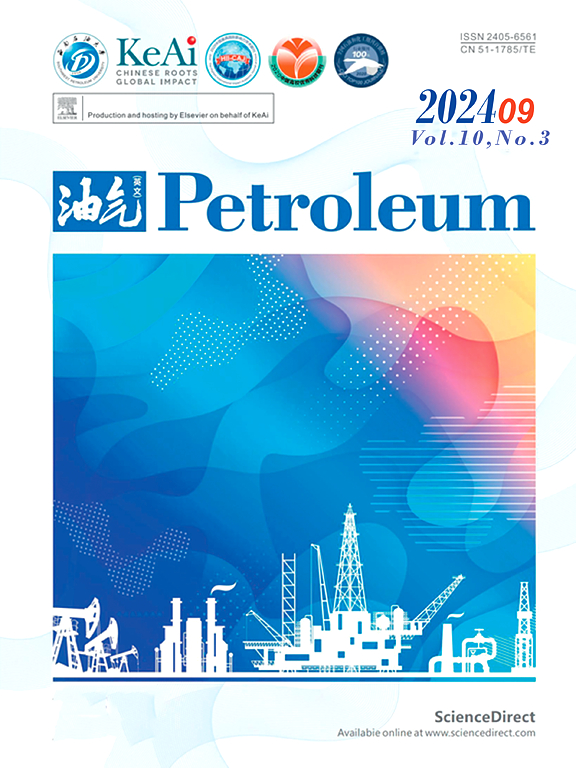The imbibition mechanism and the calculation method of maximum imbibition length during the hydraulic fracturing
IF 4.2
Q2 ENERGY & FUELS
引用次数: 0
Abstract
It was acknowledged that fluid imbibed into matrix and flooded oil during the hydraulic fracturing; however, the mechanism of fluid imbibed into matrix and flooded oil still kept unclear. Meanwhile, the maximum imbibition length calculation method was still scarce. In the paper, we firstly analyzed the imbibition mechanism during the hydraulic fracturing, and then built an imbibition length calculation method by the mercury intrusion experiment, seepage theory, and numerical calculation method. By comparing with the experimental results and model calculation results, our proposed method was verified. Finally, the influences of the maximum imbibition length were presented. From the work, it was concluded that the imbibition during the hydraulic fracturing was the counter-current imbibition with the surround pressure. The effect of the permeability on threshold pressure gradients was greater than that on the capillary pressure, which caused that the maximum imbibition length increased with an increased permeability (from 0.01 to 0.2×10-3μm2), but the time of achieving maximum imbibition lengths decreased exponentially. When the reservoir permeability was 0.1×10-3 μm2, the contact angle was 60°, and the interface tension was 50 mN/m, the maximum imbibition length was 1.8 m, and the time of achieving maximum imbibition length was 70 days. This study provided a method for evaluating the extent of imbibition draw.水力压裂时的渗吸机理及最大渗吸长度的计算方法
在水力压裂过程中,流体进入基质并被水淹;然而,流体对基质的吸附和驱油机理尚不清楚。同时,最大吸胀长度的计算方法仍然缺乏。本文首先分析了水力压裂过程中的渗吸机理,然后通过压汞实验、渗流理论和数值计算方法建立了渗吸长度计算方法。通过与实验结果和模型计算结果的比较,验证了本文方法的正确性。最后分析了最大吸胀长度对吸胀性能的影响。研究表明,水力压裂过程中的渗吸是在围压作用下的逆流渗吸。渗透率对阈值压力梯度的影响大于对毛管压力的影响,这导致最大吸胀长度随渗透率的增加而增加(从0.01到0.2×10-3μm2),但达到最大吸胀长度的时间呈指数递减。当储层渗透率为0.1×10-3 μm2,接触角为60°,界面张力为50 mN/m时,最大吸胀长度为1.8 m,达到最大吸胀长度的时间为70 d。本研究提供了一种评价吸胀程度的方法。
本文章由计算机程序翻译,如有差异,请以英文原文为准。
求助全文
约1分钟内获得全文
求助全文
来源期刊

Petroleum
Earth and Planetary Sciences-Geology
CiteScore
9.20
自引率
0.00%
发文量
76
审稿时长
124 days
期刊介绍:
Examples of appropriate topical areas that will be considered include the following: 1.comprehensive research on oil and gas reservoir (reservoir geology): -geological basis of oil and gas reservoirs -reservoir geochemistry -reservoir formation mechanism -reservoir identification methods and techniques 2.kinetics of oil and gas basins and analyses of potential oil and gas resources: -fine description factors of hydrocarbon accumulation -mechanism analysis on recovery and dynamic accumulation process -relationship between accumulation factors and the accumulation process -analysis of oil and gas potential resource 3.theories and methods for complex reservoir geophysical prospecting: -geophysical basis of deep geologic structures and background of hydrocarbon occurrence -geophysical prediction of deep and complex reservoirs -physical test analyses and numerical simulations of reservoir rocks -anisotropic medium seismic imaging theory and new technology for multiwave seismic exploration -o theories and methods for reservoir fluid geophysical identification and prediction 4.theories, methods, technology, and design for complex reservoir development: -reservoir percolation theory and application technology -field development theories and methods -theory and technology for enhancing recovery efficiency 5.working liquid for oil and gas wells and reservoir protection technology: -working chemicals and mechanics for oil and gas wells -reservoir protection technology 6.new techniques and technologies for oil and gas drilling and production: -under-balanced drilling/gas drilling -special-track well drilling -cementing and completion of oil and gas wells -engineering safety applications for oil and gas wells -new technology of fracture acidizing
 求助内容:
求助内容: 应助结果提醒方式:
应助结果提醒方式:


